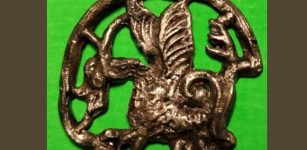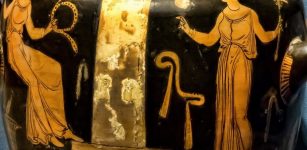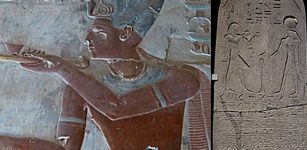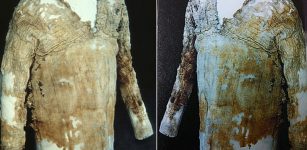Unraveling The Mystery Behind The Perplexing Story Of Pied Piper Of Hamelin
Ellen Lloyd - AncientPages.com - There was something magical about the sound of his pipe. It had a strange effect on the 130 children who followed him into the woods. They entered the cave and were never seen again.
Hundreds of years ago, something strange and unexplained happened in the small village of medieval Hameago. How could a man lure all those children into a trap, and how could they vanish without a trace?
The Pied Piper of Hamelin by James Elder Christie (1847–1914). Credit: Public Domain
Did you ever hear the story of Pied Piper of Hamelin when you were a child? The story is still often told to children worldwide, and it is a disturbing tale. As it so often is with folktales, there is, in fact, some truth in the Pied Piper story. What transpired on that crucial day if the story is based on reality?
The Pied Piper of Hamelin, also known as Pan Piper, the Rat-Catcher of Hamelin, is based on a legend from the town of Hamelin, Lower Saxony, Germany.
The mayor, in turn, promised to pay him to remove the rats. The Piper accepted and played his magical pipe to lure the rats into the Weser River, where all but one drowned.
However, he sought revenge when the villagers refused to pay for the services. He played on his pipe that had magical powers affecting the children and led them away in the same way as he got rid of the rats. He lured 130 children into the woods, where they entered a cave and were never to be seen again. One version of this disturbing story tells that three children remained behind.
One of them was lame and could not follow quickly enough, the second was deaf and followed the other children out of curiosity, and the last was blind and unable to see where he was going. These three informed the villagers of what had happened when they came out of the church. This version of the story spread as folklore and appeared in Johann Wolfgang von Goethe, the Brothers Grimm, and Robert Browning, among others. The Pied Piper is sometimes thought to have been associated with the Norse God Odin or the Anglo-Saxon counterpart Woden.
Interestingly, long before the Brothers Grimm chronicled the fairy tale in their anthology of stories, curious writings regarding the Piper story appeared.
For example, a document from 1384 about HamelinHamelin'sy states that an unrelated event took place "…100 y" ars since our children left." Dated" to about 1440 C.E., another manuscript states: "In the "year of 1284, on June 26…a piper, clothed in many kinds of colors, (there were) 130 children born in Hamelin were seduced, and lost at the place of execution near the hill." It is "also puzzling that none of the manuscripts mention of rats. Even today, the historical background of Pied Piper'sPiper's can not be proved.
Among the various interpretations, reference to the colonization of East Europe starting from Low Germany is the most plausible one: The "Children of Hameln" would have been in those days citizens willing to emigrate being recruited by landowners to settle in Moravia, East Prussia, Pomerania or in the Teutonic Land. It is assumed that in past times all people of a town were referred to as "children of the town" or "town children" as is frequently done today.
Historian Ursula Sautter, citing the work of linguist Jurgen Udolph, offers this hypothesis in support of the emigration theory: "After the defeat of the Danes at the Battle of Bornhöved in 1227," explains Udolph, "the region south of the Baltic Sea, which was then inhabited by Slavs, became available for colonization by the Germans." The bishops and dukes of Pomerania, Brandenburg, Uckermark, and Prignitz sent out glib "locators," medieval recruitment officers, offering rich rewards to those who were willing to move to the new lands.
1909 Maxfield Parrish mural of the Pied Piper of Hamlin at the Palace Hotel, San Francisco. Credit: Public Domain
Several researchers have studied the Pied Piper story to unravel the mystery, but without any success. Thousands of young adults from Lower Saxony and Westphalia headed east. And as evidence, about a dozen Westphalian place names show up in this area. Indeed there are five villages called Hindenburg running in a straight line from Westphalia to Pomerania, as well as three eastern Spiegelbergs and a trail of etymology from Beverungen south of Hamelin to Beveringen northwest of Berlin to Beweringen in modern Poland.
Many theories have been put forward. Some suggest that children died of natural causes such as disease or accident and that the Piper was a symbolic figure of Death.

Modern concepts of Death Today people tend not to believe that a grim reaper will appear at their door when it is time to depart from this life.
Analogous themes associated with this theory include the Dance of Death, Totentanz, or Danse Macabre, a common medieval trope. Some of the scenarios suggested as fitting this theory include that the children drowned in the river Weser were killed in a landslide, or contracted some disease during an epidemic. Another modern interpretation reads the story as alluding to an event where Hamelin children were lured away by a pagan or heretic sect to forests near Coppenbrügge (the mysterious Koppen "hills" of the" poem) for ritual dancing where they all perished during a sudden landslide or collapsing sinkhole.
Others have suggested that the children left Hamelin to be part of a pilgrimage, a military campaign, or even a new Children's crusade (which is said to have occurred in 1212) but never returned to their parents. These theories see the unnamed Piper as their leader or a recruiting agent. The townspeople made up this story (instead of recording the facts) to avoid the church's wrath or the king.
The identity of Pied Piper remains a mystery. We also do not know what happened to all those children who vanished and were never seen again. Ask yourself why 130 children would willingly follow a stranger into the woods. Perhaps we will never find out what happened, but think twice before telling your child this story next time.
Updated on December 12, 2023
Written by – Ellen Lloyd - AncientPages.com
Copyright © AncientPages.com All rights reserved. This material may not be published, broadcast, rewritten or redistributed in whole or part without the express written permission of AncientPages.com
Refe "ences:
References:
Stadt Hamel – Pied Piper
University of Pittsburgh - The Pied Piper of Hameln
More From Ancient Pages
-
 Did Democracy Have A Separate Origin In The Americas?
Archaeology | Jun 15, 2022
Did Democracy Have A Separate Origin In The Americas?
Archaeology | Jun 15, 2022 -
 History Of The Saltire – Scotland’s National Flag And World’s Oldest Sovereign Flag
Featured Stories | Apr 3, 2016
History Of The Saltire – Scotland’s National Flag And World’s Oldest Sovereign Flag
Featured Stories | Apr 3, 2016 -
 Fenrir: Oldest Of Three Monstrous Children Of God Loki In Norse Mythology
Featured Stories | Mar 28, 2018
Fenrir: Oldest Of Three Monstrous Children Of God Loki In Norse Mythology
Featured Stories | Mar 28, 2018 -
 Two Rare Full-Sized Viking Burial Ships Uncovered In Sweden
Archaeology | Jul 5, 2019
Two Rare Full-Sized Viking Burial Ships Uncovered In Sweden
Archaeology | Jul 5, 2019 -
 Sir Marc Aurel Stein: Famous Fascinating Expeditions To Ancient Places Of The Silk Road
Civilizations | Feb 11, 2016
Sir Marc Aurel Stein: Famous Fascinating Expeditions To Ancient Places Of The Silk Road
Civilizations | Feb 11, 2016 -
 Ancient Miracle Man Possessed Extraordinary Levitation And Telepathic Abilities That Shocked People
Featured Stories | Jun 21, 2018
Ancient Miracle Man Possessed Extraordinary Levitation And Telepathic Abilities That Shocked People
Featured Stories | Jun 21, 2018 -
 Mystery Of Great Wall Of California: An Ancient Unsolved Enigma
Civilizations | Sep 11, 2018
Mystery Of Great Wall Of California: An Ancient Unsolved Enigma
Civilizations | Sep 11, 2018 -
 DNA Sheds Light On Ancient History Of Dogs All The Way To The Ice Age
Archaeology | Oct 30, 2020
DNA Sheds Light On Ancient History Of Dogs All The Way To The Ice Age
Archaeology | Oct 30, 2020 -
 Monumental Structure Unearthed During Excavations Of Urartu-Era Karmir Blur
Archaeology | Nov 25, 2022
Monumental Structure Unearthed During Excavations Of Urartu-Era Karmir Blur
Archaeology | Nov 25, 2022 -
 Dingoes Given ‘Almost-Human’ Status In Pre-Colonial Australia – Archaeological Study Finds
Archaeology | Oct 21, 2023
Dingoes Given ‘Almost-Human’ Status In Pre-Colonial Australia – Archaeological Study Finds
Archaeology | Oct 21, 2023 -
 How Strong Is The Link Between Sanskrit And European Languages?
Linguistic Discoveries | Aug 5, 2020
How Strong Is The Link Between Sanskrit And European Languages?
Linguistic Discoveries | Aug 5, 2020 -
 Satellites Discover Over 160 Hidden Ancient Mounds In North America
Archaeology | Aug 2, 2018
Satellites Discover Over 160 Hidden Ancient Mounds In North America
Archaeology | Aug 2, 2018 -
 Ancient Marble Statue Of Sphinx Discovered In Tang Dynasty Tomb
Archaeology | Dec 16, 2015
Ancient Marble Statue Of Sphinx Discovered In Tang Dynasty Tomb
Archaeology | Dec 16, 2015 -
 Medieval Pilgrim’s Badge (‘Pilgrim’s Sign’) Depicting A Basilisk Dragon In A Circle Discovered In Southeastern Poland
Artifacts | Mar 5, 2024
Medieval Pilgrim’s Badge (‘Pilgrim’s Sign’) Depicting A Basilisk Dragon In A Circle Discovered In Southeastern Poland
Artifacts | Mar 5, 2024 -
 What Caused The Year Without A Summer In 1816?
Ancient History Facts | Sep 17, 2018
What Caused The Year Without A Summer In 1816?
Ancient History Facts | Sep 17, 2018 -
 Societies In Iberian Peninsula Deployed “Escape Economics” 4,000-Year-Old
Archaeology | Sep 28, 2022
Societies In Iberian Peninsula Deployed “Escape Economics” 4,000-Year-Old
Archaeology | Sep 28, 2022 -
 Mysterious Book That ‘Killed’ – Are Written Or Spoken Words Powerful Enough To Take Control Over Our Actions?
Featured Stories | Nov 21, 2022
Mysterious Book That ‘Killed’ – Are Written Or Spoken Words Powerful Enough To Take Control Over Our Actions?
Featured Stories | Nov 21, 2022 -
 Apulian Secrets: Ancient Burial Rituals Shed Light On A Culture That Left No Written History
Archaeology | Jan 12, 2016
Apulian Secrets: Ancient Burial Rituals Shed Light On A Culture That Left No Written History
Archaeology | Jan 12, 2016 -
 Egyptian King Seti I Documented His 3300-Year-Old Accomplishment On Triumphal Stele
Archaeology | Feb 27, 2023
Egyptian King Seti I Documented His 3300-Year-Old Accomplishment On Triumphal Stele
Archaeology | Feb 27, 2023 -
 Tarkhan Dress – The World’s Oldest Woven Garment
Archaeology | Feb 24, 2016
Tarkhan Dress – The World’s Oldest Woven Garment
Archaeology | Feb 24, 2016



